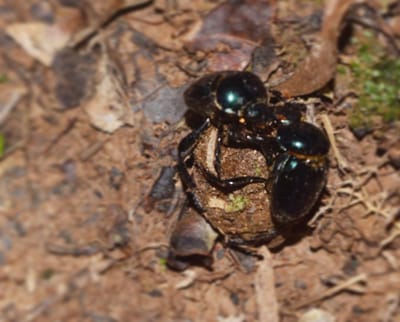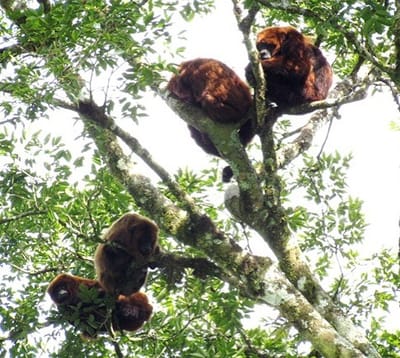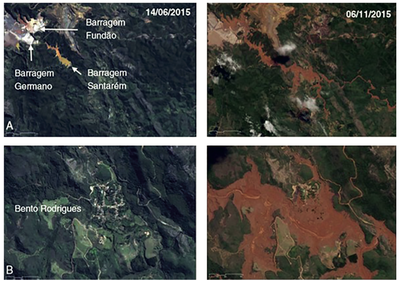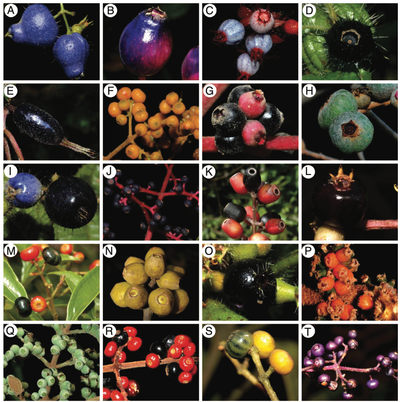LISIEUX FUZESSY
Ecology, Biodiversity and Conservation
About me
The main line of my research is twofold. The first attempts to study the biodiversity with a special focus on ecological interactions, and paying particular attention to eco-evolutionary aspects of mutualisms. The second attempts to understand the role of ecological traits in the response of animals to environmental changes and the implications to ecology and evolution. To address these two lines, I integrate studies on species morphology, ecology and phylogeny. I often use a macroevolutionary approach, mainly using primates and birds as a study model, and combining big datasets with information from the literature.
I am currently a MSCA Posdoctoral fellow at the CREAF, a Severo Ochoa Excellence Centre located at the Autonomous University of Barcelona, Spain. I work in collaboration with Dr. Daniel Sol and his team. The main goal of my research is to uncover the consequences of the loss of ecological and phylogenetic complexity within biological communities to ecosystem functioning.

ENVIRON_CHANGE

ENVIRON_CHANGE is a EU-funded project, a Marie Skłodowska-Curie Individual Fellowship (Horizon 2020-MSCA-IF-2020). I will investigate the impact of environmental change on ecosystem functions and evolutionary history over time through an interdisciplinary approach. By applying long-term monitoring and surveying, niche analysis, GIS tools, phylogenetic comparative analyses and ecological modelling. I aim to understand why certain species are more able to cope with habitat alteration than others. This will provide insights into the long-term consequences of urbanisation and agriculture on the biodiversity of avian communities. The project will allow for a more detailed picture of the impact of land use change on biodiversity, which can better inform management decisions and assess the extent to which functional and phylogenetic diversities are more protected in species-rich assemblages.
https://cordis.europa.eu/project/id/101030199
Research interests
Community Ecology
Eco-evolutionary dynamics of ecosystems
Ecological Interactions
Functional traits
Environmental changes
Functional and phylogenetic diversities
Meta-analysis
Timeline
Msc in Zoology
I began my career interested in morphological traits related to hybridization among non-native primates introduced by humans to urban forests (MSc 2011-2013).
1/12/2013PhD in Plant biology
During my PhD (2013-2017), under the supervision of Dr. Fernando A O Silveira (Federal University of Minas Gerais, Brazil), I further developed multiple interests within the field of the ecology of mutualistic interactions, exploring the complex role of primates as seed dispersers. It was my first contact with large datasets, although still geographically restricted to Neotropical forests.
27/07/2017PhD Internship
During my PhD I did a 10-mo internship at the University of Montana - USA (2015), where in addition of improving my English writing and communication skills, I received strong training in meta-analysis, ecological modelling and R programming.
20/12/2015Postdoc position - UNESP, Brazil
My training during my PhD prepared me to further explore innovative approaches in my first post doc position (2017-2020), at Universidade Estadual Paulista, Brazil, financed by FAPESP (São Paulo Research Foundation). During this experience, working closely with Dr. Laurence Culot (Universidade Estadual Paulista, Brazil), I progressively integrated a broader spectrum of interacting organisms (from insects to vertebrates and plants) and ecological complexity into my research. Conducting research in a wide scope of study systems is difficult, as it requires expertise and skills of different disciplines and approaches. Yet, one advantage is that it allows to perceive distinct angles of similar questions, especially when investigating ecological patterns involving both animals and plants.
30/06/2021Postdoc Stay - EBD Doñana
During a 11-mo stay (2019) at the Estación Biológica Doñana (EBD-CSIC, Spain) as part of my post- doc fellowship from FAPESP, I expanded my research network, trained English and Spanish communication skills and also received technical training. I worked closely with Dr. Pedro Jordano (Estación Biologica de Doñana, CSIC), a world-renowned researcher in the field of complex networks, and also reinforced my meta-analysis background collaborating with Dr. Ana Benítez-Lopez (Granada University). The interaction with experienced researchers from different countries, institutes and international conferences, gave me great independence in the use of new techniques, and in understanding novel approaches and points-of-view. At this time I also had the opportunity to work closely with Dr. Miguel Verdu (Desertification Research Center, CSIC), world-renowned expert on evolutionary aspects of ecological interactions.
20/12/2019MSCA Postdoc position - CREAF, Spain
I am currently a MSCA Posdoctoral fellow at the CREAF, a Severo Ochoa Excellence Centre located at the Autonomous University of Barcelona, Spain. I work in collaboration with Dr. Daniel Sol and his team. In my current position I have being responsible for designing, executing, analysing data, writing up my research and also supervise students. My main goal is to uncover the consequences of the loss of ecological and phylogenetic complexity within biological communities to ecosystem functioning.
8/12/2022Last publications

Small but Nice–Seed Dispersal by Tamarins Compared to Large Neotropical Primates
Authors: EW Heymann, L Fuzessy, L Culot. 2022. ABSTRACT: Tamarins, small Neotropical primates of the genera Saguinus and Leontocebus, have a mainly frugivorous-faunivorous diet. While consuming the pulp of a high diversity of fruit species, they also swallow seeds and void them intact, thus acting as seed dispersers. Here we compare different aspects of the seed dispersal ecology of tamarins with that of large Neotropical primates from the genera Ateles (spider monkeys) and Lagothrix (woolly monkeys). Due to their small body size, tamarins disperse seeds of a smaller size range, fewer seeds per defecation, and seeds from a smaller number of different plant species per defecation compared to these atelines. We discuss whether tamarin seed dispersal is redundant or complementary to seed dispersal by atelines. On the level of plant species, our comparisons suggest that redundancy or complementarity depends on the plant species concerned. On the habitat level, seed dispersal by tamarins and large New World primates is probably complementary. Particularly, since tamarins are capable of persisting in disturbed forests and near human settlements, they are more likely to contribute to the natural regeneration of such areas than larger primates.
Read More
Phylogenetic congruence between Neotropical primates and plants is driven by frugivory
Authors: L. Fuzessy, FAO Silveira, L Culot, P. Jordano, M. Verdú, M. Ecology Letters 25, 320-329. ABSTRACT: Seed dispersal benefits plants and frugivores, and potentially drives co-evolution, with consequences to diversification evidenced for, e.g., primates. Evidence for macro-coevolutionary patterns in multi-specific, plant-animal mutualisms is scarce, and the mechanisms driving them remain unexplored. We tested for phylogenetic congruences in primate-plant interactions and showed strong co-phylogenetic signals across Neotropical forests, suggesting that both primates and plants share evolutionary history. Phylogenetic congruence between Platyrrhini and Angiosperms was driven by the most generalist primates, modulated by their functional traits, interacting with a wide-range of Angiosperms. Consistently similar eco-evolutionary dynamics seem to be operating irrespective of local assemblages, since co-phylogenetic signal emerged independently across three Neotropical regions. Our analysis supports the idea that macroevolutionary, coevolved patterns among interacting mutualistic partners are driven by super-generalist taxa. Trait convergence among multiple partners within multi-specific assemblages appears as a mechanism favouring these likely coevolved outcomes
Read More
Anthropogenic impacts on plant-animal mutualisms: A global synthesis for pollination and seed dispersal.
Authors: AL Teixido, L Fuzessy, CS Souza, IN Gomes, LA Kaminski, PC Oliveira and PK Maruyama. Biological Conservation 266, 109461. ABSTRACT: Global anthropogenic changes cause major impacts on species interactions, with cascading effects on ecosystem functioning. Animal-mediated pollination and seed dispersal are major mutualisms associated with distinct stages of plant reproduction. Nevertheless, we lack an integrated assessment on how multiple anthropogenic impacts affect these interrelated mutualisms. Here, we systematically reviewed the effect of the most important global anthropogenic factors (agrochemicals, climate change, fire, fragmentation, hunting, non-native species and urbanization) on pollination and seed dispersal. We evaluated which anthropogenic factors, mutualisms and their combinations have been more frequently investigated, the biogeographic and taxonomic tendencies and the most frequently recorded effects of anthropogenic factors. We show that pollination has been more broadly investigated, that the impacts of the anthropogenic factors on pollination and seed dispersal are biased towards the temperate region and forest biomes and lack representation from some relevant groups, such as mutualistic bats. Moreover, some anthropogenic factors have been more studied for one mutualism type in relation to the other, for instance, agrochemicals and urbanization on plant-pollinator interactions, even though these impacts could also generate direct and cascading effects on frugivores and seed dispersal. The predominance of negative effects observed, especially of climate change on plant-pollinator and non-native species on plant-frugivore interactions deserve special attention. Finally, we identify a gap in empirical studies that simultaneously consider pollination and seed dispersal as integrated components of plant reproduction, and combined anthropogenic factors in the same ecosystem. More integrative studies are needed to better understand the vulnerability of plant-animal mutualisms in a changing world.
Read More
Funcional roles of frugivores and plants shape hyper-diverse mutualistic interactions under two antagonistic conservation scenarios.
Authors: Lisieux Fuzessy, Gisela Sobral, Daiane Carreira, Débora Cristina Rother, Gedimar Barbosa, Mariana Landis, Mauro Galetti, Tad Dallas, Vinícius Cardoso Cláudio, Laurence Culot, Pedro Jordano Biotropica 54, 444-454. ABSTRACT: Disentangling the structure of plant–animal mutualisms shed light on how species are organized, and allow us to infer about resilience, specificity, and ultimately the consequences of the loss of functions to the ecosystem. Here we gathered fruit–frugivore interactions for all the major vertebrate taxa interacting with plants in two conservation states in the Brazilian Atlantic forest: a small patch and a continuous forest. Using a network approach, we identified individual roles played by vertebrates and plants, as well as the most relevant functional traits determining the network structure. The most important vertebrates in the continuous forest were the frugivorous characterized by the ability to swallow fruits containing small to large seeds, but they also were the first to be vanished from the small patch decades ago. Animal gape/gullet size, but not body mass, together with the greatest degrees of frugivory contributed to structure the conserved community. In the forest patch, where specialization degrees (in terms of number of interactions performed) were lost, small generalist birds and the only still living primate, along with small lipid-rich fruits, were central in maintaining community structure. This study brings insights on the potential of conserved forests to hold important species-rich interactions, at the same time that small patches count on small birds and small fruits with increased energetic rewards to maintain structuring under human degradation threats. Our results reemphasize the importance of preserving large continuous forest remnants to support important mutualistic interactions subjected to functional traits already lost in small degraded patches.
Read More
Identifying the anthropogenic drivers of declines in tropical dung beetles and functions.
Authors: L Fuzessy, A Benítez-López, EM Slade, (…) and Laurence Culot. 2021. Biological Conservation 256, 109063. ABSTRACT: Human population growth and the activities resulting in habitat destruction are a threat to biodiversity worldwide. Despite the recognized importance of dung beetles in supporting tropical forest ecosystems, our understanding of their susceptibility to anthropogenic pressures remains limited. Previous research detailed the overall consequences of habitat loss driven by human activities to tropical dung beetle assemblages and traits. The work pointed out main knowledge gaps and outlined future work inspiring a surge in research. After a decade, we build upon the previous review, and bring an update to this topic with the aim of disentangling the confounding drivers impacting dung beetle responses. Using a comprehensive meta-analytical approach, we address the main geographical constraints and limitations, summarize the most up-to-date information, and draw new conclusions on the consequences of human activities to dung beetles. Our results help to draw together the patterns defining how human activities alter dung beetle abundance, species richness, community diversity and evenness. We show that beetle assemblage composition depends upon the origin and intensity of forest conversion, and has consequences for dung beetle associated ecosystem functions. Finally, we demonstrate that the depletion of large vertebrates throughout the tropics has indirect effects on beetle communities. As a consequence, anthropogenic actions are likely to harm dung beetle populations both directly, through habitat loss, and indirectly, through the cascading effects of the loss of large mammals.
Read More
Linking howler monkey ranging and defecation patterns to primary and secondary seed dispersal
Authors: L Fuzessy, G Sobral, L Culot. American Journal of Primatology 84, e23354 To define the chances of a dispersed seed to produce a new recruit, it is essential to consider all stages of the dispersal process. Howler monkeys are recognized to have positive impacts on forest regeneration, acting as primary dispersers. Furthermore, dung beetles attracted to their feces protect the seeds against predators, and provide a better microenvironment for germination due to the removal of fecal matter, to seed burial, and/or by reducing the spatial aggregation of seeds in fecal clumps. Despite the recognized positive effects of primary seed dispersal through defecation by howler monkeys for plant recruitment, there are some important aspects of their behavior, such as the habit of defecating in latrines, that remain to be explored. Here, we investigated the fate of Campomanesia xanthocarpa seeds defecated by brown howlers, Alouatta guariba clamitans, and the secondary seed dispersal by dung beetles, considering how this process is affected by the monkey's defecation patterns. We found that brown howler monkeys dispersed seeds from several species away from fruit-feeding trees, partly because defecation under the canopy of such trees was not very frequent. Instead, most defecations were associated with latrines under overnight sleeping trees. Despite a very similar dung beetle community attracted to howler feces in latrines and fruit-feeding sites, seeds were more likely to be buried when deposited in latrines. In addition, C. xanthocarpa seeds showed higher germination and establishment success in latrines, but this positive effect was not due to the presence of fecal matter surrounding seeds. Our results highlight that A. guariba clamitans acts as a legitimate seed disperser of C. xanthocarpa seeds in a preserved context of the Brazilian Atlantic Forest and that defecations in latrines increase the dispersal effectiveness.
Read MoreAre palms a good model to explain primate colour vision diversification? A comment on Onstein et al. 2020
Authors: Eckhard W. Heymann and Lisieux Franco Fuzessy Proceedings of the Royal Society B, 2882020142320201423
Read More
Dam failure and mammals: a portrait of the scenario prior to Mariana disaster.
Authors: G sobral G Guilhon, F Gudinho, S Sicilliano and L Fuzessy Brazilian Journal of Mammalogy. ABSTRACT: Brazil experienced the largest socioenvironmental catastrophe of its history, caused by a tailings dam failure, known as “Mariana disaster”. The wave of iron-mining waste buried villages, contaminated the Doce River, and left an immense ocean plume. The Doce River watershed is the largest in southeast Brazil, and located in the Atlantic Forest domain, presenting an outstanding economic, social, and biological relevance. Although the effects of such tragic events are usually assessed through fish assemblage changes, mammals have important effects on environment structure and regeneration. Inventories are of prime importance for adequate conservation efforts as well as for evaluating impacts of any disaster. Therefore, the aim of this paper was to present an updated assessment of mammalian list collected in the affected portion of Doce River before the dam failure therefore contributing to future conservation efforts. Data collection comprised specimens deposited in Museu Nacional/UFRJ, the oldest mammal collection of Brazil, and literature review. The two surveys together retrieved 157 species from 31 families and 11 orders, representing around 60% of the known mammalian diversity in the Atlantic Forest, including some in critical conservation condition, such as the Franciscana dolphin, the northern muriqui and the giant otter. Mining is a byproduct of present society, with dam breaches as a recurring problem. Facing the importance of Doce River to both Brazilian biodiversity and society, the chain of events must be taken into account in environmental rehabilitation strategies, and taxa less commonly assessed, like mammals, should be included.
Read More
Frugivory and seed dispersal in a hyper-diverse plant clade and its role as a keystone resource for the Neotropical fauna
Authors: JVS Messeder, FAO Silveira, TG Cornelissen, L Fuzessy and TJ Guerra. Annals of botany 127(5), 577-595. Background and Aims Much of our understanding of the ecology and evolution of seed dispersal in the Neotropics is founded on studies involving the animal-dispersed, hyperdiverse plant clade Miconia (Melastomataceae). Nonetheless, no formal attempt has been made to establish its relevance as a model system or indeed provide evidence of the role of frugivores as Miconia seed dispersers. Methods We built three Miconia databases (fruit phenology/diaspore traits, fruit–frugivore interactions and effects on seed germination after gut passage) to determine how Miconia fruiting phenology and fruit traits for >350 species interact with and shape patterns of frugivore selection. In addition, we conducted a meta-analysis evaluating the effects of animal gut passage/seed handling on Miconia germination. Key Results Miconia produce numerous small berries that enclose numerous tiny seeds within water- and sugar-rich pulps. In addition, coexisting species provide sequential, year long availability of fruits within communities, with many species producing fruits in periods of resource scarcity. From 2396 pairwise interactions, we identified 646 animal frugivore species in five classes, 22 orders and 60 families, including birds, mammals, reptiles, fish and ants that consume Miconia fruits. Endozoochory is the main dispersal mechanism, but gut passage effects on germination were specific to animal clades; birds, monkeys and ants reduced seed germination percentages, while opossums increased it. Conclusions The sequential fruiting phenologies and wide taxonomic and functional diversity of animal vectors associated with Miconia fruits underscore the likely keystone role that this plant clade plays in the Neotropics. By producing fruits morphologically and chemically accessible to a variety of animals, Miconia species ensure short- and long-distance seed dispersal and constitute reliable resources that sustain entire frugivore assemblages.
Read MoreContact
- Edifici C, Facultat de Ciències i Biociències, Universitat Autònoma de Barcelona
- 08193 Bellaterra, Barcelona



